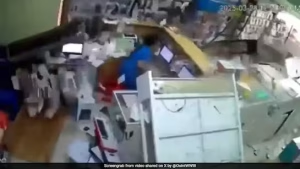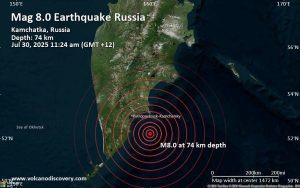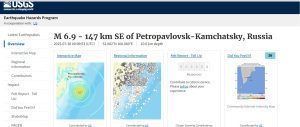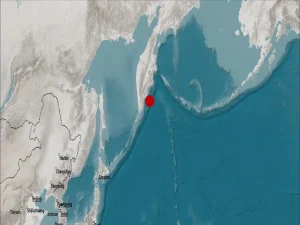A devastating Russia Earthquake struck the Kamchatka Peninsula on Tuesday, July 29, registering a powerful magnitude of 8.7 on the seismic scale. This massive Russia Earthquake sent shockwaves through the remote region, causing widespread building damage and triggering concerns about potential casualties. The United States Geological Survey confirmed the earthquake’s significant impact on the sparsely populated but geologically active peninsula.
The Russia Earthquake epicenter was precisely located 133 kilometers southeast of Petropavlovsk-Kamchatsky, the largest city in the Kamchatka region. Geological data indicates that this Russia Earthquake originated at a depth of 74 kilometers beneath the Earth’s surface, contributing to its widespread impact across the peninsula and surrounding areas.
Terrifying Videos Capture Building Destruction
Dramatic footage emerged immediately following the Russia Earthquake, showing buildings violently shaking as the powerful seismic waves swept through populated areas. These scary videos documented the intense moments when structures swayed dangerously, with some buildings suffering visible damage from the earthquake’s tremendous force.
Witnesses in the affected regions captured the Russia Earthquake impact on residential and commercial buildings, revealing the true scale of destruction caused by the 8.7 magnitude tremor. The videos showed furniture moving, windows rattling, and people struggling to maintain balance as the ground beneath them shifted violently during the seismic event.
Widespread Damage Across Multiple Locations

Reports of damage from the Russia Earthquake began flowing in from various locations across the Kamchatka Peninsula. Multiple settlements experienced structural damage to buildings, with the extent of destruction still being assessed by local authorities and emergency response teams.
The Russia Earthquake caused significant concerns about infrastructure integrity, particularly in areas with older construction that may not have been designed to withstand such powerful seismic activity. Building inspections are likely to reveal the full scope of structural damage caused by this major earthquake.
Also Read: Midtown NYC Shooting Suspect Shane Tamura Kills Himself After Terror
Uncertain Casualty Situation Raises Concerns
As information continues to emerge about the Russia Earthquake, the number of potential injuries remains unclear. The remote location of the Kamchatka Peninsula and the vast distances between settlements have complicated immediate damage assessment and casualty reporting efforts.
Emergency response teams are working to establish communication with all affected areas following the Russia Earthquake to determine if there have been any injuries or fatalities. The sparse population density of the region may have helped minimize human casualties, but official confirmation is still pending.
First Tsunami Waves Strike Pacific Coast
The powerful Russia Earthquake triggered tsunami waves that began hitting the Pacific coastline of the Kamchatka region shortly after the initial seismic event. Dramatic photos and videos captured these first waves as they reached the Russian coast, demonstrating the earthquake’s capacity to generate dangerous secondary effects.
Coastal areas experienced significant sea level rises as the Russia Earthquake-generated tsunami waves approached the shoreline. Buildings in coastal towns witnessed alarming increases in water levels, creating additional hazards for residents and infrastructure in low-lying areas near the Pacific Ocean.
Geological Significance of Kamchatka Peninsula


The Kamchatka Peninsula sits along the volatile Pacific Ring of Fire, making Russia Earthquake events relatively common in this geologically active region. This particular earthquake’s 8.7 magnitude places it among the most powerful seismic events recorded in the area, highlighting the peninsula’s susceptibility to major geological disturbances.
The Russia Earthquake occurred in a region known for its numerous active volcanoes and frequent seismic activity. The peninsula’s location at the intersection of several tectonic plates creates conditions conducive to powerful earthquakes and volcanic eruptions.
Emergency Response and Assessment Efforts
Local authorities and emergency services immediately mobilized following the Russia Earthquake to assess damage and coordinate rescue efforts. The remote nature of many affected areas presents significant challenges for rapid response and comprehensive damage evaluation.
Communication networks experienced disruptions from the Russia Earthquake, complicating efforts to maintain contact with isolated communities throughout the peninsula. Emergency teams are working to restore communications and establish the full extent of the earthquake’s impact on regional infrastructure.
International Monitoring and Support


The Russia Earthquake magnitude and location triggered international attention from seismological monitoring agencies worldwide. The United States Geological Survey provided crucial data about the earthquake’s characteristics, helping to coordinate international understanding of this significant seismic event.
Global tsunami warning systems activated following the Russia Earthquake to monitor potential wave propagation across the Pacific Ocean. International cooperation in earthquake monitoring demonstrates the global significance of such powerful seismic events.
Ongoing Aftershock Concerns


Seismologists expect numerous aftershocks following this major Russia Earthquake, potentially causing additional damage to already weakened structures. Residents in affected areas have been advised to remain vigilant for continued seismic activity in the coming days and weeks.
The Russia Earthquake aftermath will likely include extensive geological surveys to better understand the fault systems involved and assess the potential for future seismic activity in the region, contributing to improved earthquake preparedness and response strategies.

